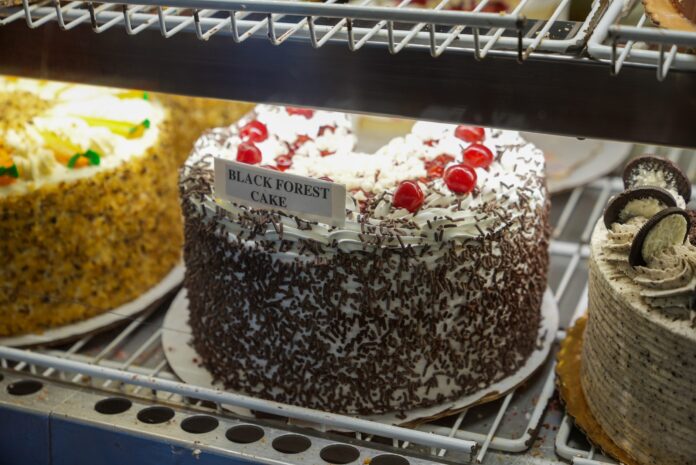
In Greek culture, dessert symbolizes appreciation and hospitality. “If you visit a Greek home, there is basically zero chance you won’t be offered food, and it will most likely be sweet,” says Diana Moutsopolous, editorial director of Allrecipes, Greek cuisine expert and daughter of Greek restaurateurs.
Traditionally, Moutsopolous says, people will offer a spoon sweet known as glyko tou koutaliou, or “sweet from the spoon.” This might include preserved fruits, nuts, or even vegetables served by the teaspoon on a small plate, accompanied by a glass of water.
“Other than spoon sweets, it would be common to offer a slice of cake, such as a humble marble cake, or cookies, especially during peak baking seasons of Christmas and Easter when every Greek household makes koulourakia (Greek Easter cookies), melomakarona (Greek Christmas honey cookies), and kourambiedes (Greek Christmas shortbread cookies),” she explains. “These are enjoyed throughout the year, but especially when Greeks fast for Lent, and they go great with a cup of coffee.”
When you walk into an old-school diner, especially a Greek-owned diner, you’re instantly greeted by a gleaming case filled with cakes. The selection of cakes and cheesecakes is joined by pies, pudding, and eclairs – and yes, the location is entirely intentional.
“Where you place the dessert case has to be right in front of the front door,” says Marietta Diner owner Gus Tselios. “You must see it on the way in and on the way out. It sends a message when you walk in that you’re in a real Northern diner. Number two, it looks pretty.”

Those dessert cases set an intention in customers’ minds. Perhaps they’ll choose a lighter entree to save room for dessert or purchase a slice of cake to take home. People make decisions about their meals when they walk inside, says Ahmet Toker, part owner of Metro Diner in downtown Atlanta and Stone Mountain. In the restaurant industry, it’s called “planting the seed.”
Traditionally, diners showed off desserts in a rotating case, but newer operations lean toward glass cases. The glass case keeps all the desserts in a central location which helps ease navigation in and around the display. The rotating displays can get in the way. But the rotating case also allows a restaurant to display its entire dessert inventory rather than a select few. The more options a customer sees, the higher the likelihood they’ll indulge in dessert after their meal.
“I remember the revolving dessert case at my parent’s restaurants vividly,” Moutsopolous says. “It was filled with homemade desserts ranging from lard-crust pies and baklava to humble rice pudding with raisins to creamy layered Midwestern tortes with ripples of cool whip and pudding.”
Her parents always displayed their best desserts, all made in-house at the restaurant, with the case strategically placed near the entrance to the dining room. People passed by it before they sat down for a meal and walked by it before paying at the cash register.
Cakes don’t last long once moved from refrigeration to the dessert case out front.
“You’ve got to worry about keeping up with how much you need,” Tselios says. Marietta Diner, for example, sells hundreds of slices daily, with many of those slices ordered to go. A massive slice of cake, easily split between two to three people, costs around $9 to $10.

The diner cake experience includes how slices come presented to customers. Cake slices are better when freshly cut to retain moisture. Toker says pre-cut slices or desserts displayed on a countertop lack the quality and hospitality that comes with a fresh slice of cake. Metro Diner seals the edges of any remaining cakes on display with wax paper to maintain freshness.
Quintessential diner cake cases feature customer favorites like New York-style cheesecake, chocolate cake, red velvet cake, and strawberry shortcake. Other popular cake flavors include Black Forest, Italian cream, and carrot, although selections differ based on the diner and its customers’ preferences.
Landmark Diner in Buckhead makes all its cakes in-house. The most popular flavor here is chocolate, with tiramisu cake as the restaurant’s most unique flavor. Bakers at Marietta Diner make most cakes in-house, too, although a few specialty Greek items come from Zukerino Pastry Shop in Dunwoody. The most popular flavor is strawberry cheesecake. But the most unique dessert on display at Marietta Diner is the baklava cheesecake — a nod to diners’ shared history with Greek restaurateurs in America.
A wave of Greek immigrants traveled to New York and the Northeast in the 1880s, and many found employment at restaurants all over the region. Eventually, these former dishwashers and bussers saved enough money to buy the restaurants outright.

Although not all Metro Atlanta diners make cakes on-site, these restaurants do commit to sourcing locally. Metro Diner sources cakes from Alpharetta-based Alpine Bakery, with its most popular cake being Oreo cheesecake and its most unique cake the apple graham cracker cheesecake. Like Marietta Diner, Sandy Springs Diner also sources desserts from Zukerino Pastry Shop. The most popular cake with its customers is German chocolate, while the most unique is the coconut cake.
Customers enjoy cake throughout the day, but Toker and Tselios have noticed people are more likely to indulge in diner desserts late at night — people crave edible debauchery. Toker adds that customers visiting the downtown Atlanta location of Metro Diner — DragonCon attendees make up a substantial portion of the customer base during the Labor Day weekend event — tend to celebrate their trip with a slice of cake.
While people enjoy coffee or a milkshake with their cake at a diner, don’t discount pairing a slice with a glass of wine or a cocktail. Toker recommends pairing a lighter flavor, such as strawberry shortcake, with a crisp chardonnay.
“When you eat cake, you want to pair it right,” says Toker. “If there’s any tartness in the cake like lemon pie, you don’t want to drink coffee because you’re not going to enjoy either [the dessert or the coffee].”
